
Soil health involves the fundamentals associated with soil, crops, and overall agricultural management practices that serve to enhance good soil system function. The concept of soil health basically addresses how well a soil is functioning. A simple analogy is with human health and as we see with a healthy person there is good overall system function and there are many interactive components in soil systems, like the human health system.
Soil health has been defined by the U.S. Department of Agriculture Natural Resource Conservation Service as “The continued capacity of a soil to function as a vital living ecosystem that sustains plants, animals, and humans” (USDA-NRCS, 2022).
The principles of soil health include soil quality parameters that serve to maximize biodiversity, soil cover, encouraging strong plant root system development, reduced tillage and practices that minimize soil disturbance, and will develop good soil conditions that are conducive to better infiltration and soil water holding capacity, sequester carbon (C), improve nutrient cycling, enhance ecosystem services, and many other benefits that are associated with healthy soils. Thus, soil health represents an extremely broad set of concepts and functions, and it is a good way to present the holistic aspects of soil systems.
As an agronomist and soil scientist working professionally for over 45 years, I find it interesting that what is now commonly referred to as “soil health” might be a new term but it is not a recent discovery. What is often referred to as soil health has often been described for many years as “soil quality” (NRCS, 2015).
Soil quality is the ability of a soil to perform the basic functions necessary for its intended use. These soil system functions typically include:
● sustaining biological diversity, activity, and productivity
● regulation of water and solute flow
● filtering, buffering, degrading organic and inorganic materials
● storing and cycling nutrients and carbon
● providing physical stability and support
Soils have been recognized as living entities for many decades and we commonly address soil function in terms of the three categories of physical, chemical, and biological properties. However, these categories overlap in function and are not always clearly defined as an independent soil property in a soil system since each can affect multiple soil functions.
Thus, soil health serves to integrate the dynamic functions of a soil system among the physical, chemical, and biological properties associated within a given soil system (Figure 1).
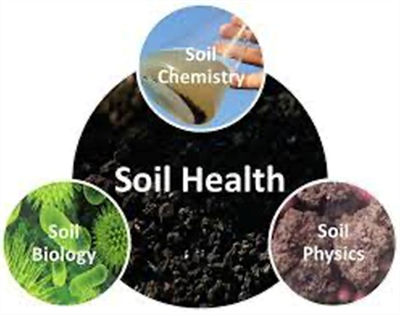
Figure 1. Soil health and the integration of fundamental soil
properties. Source: University of Tennessee Cooperative Extension.
One of the principal aspects of soil health is the emphasis on the relationship between soils and soil systems to human health via the function of soils as a fundamental component of terrestrial ecosystems, Figure 2.
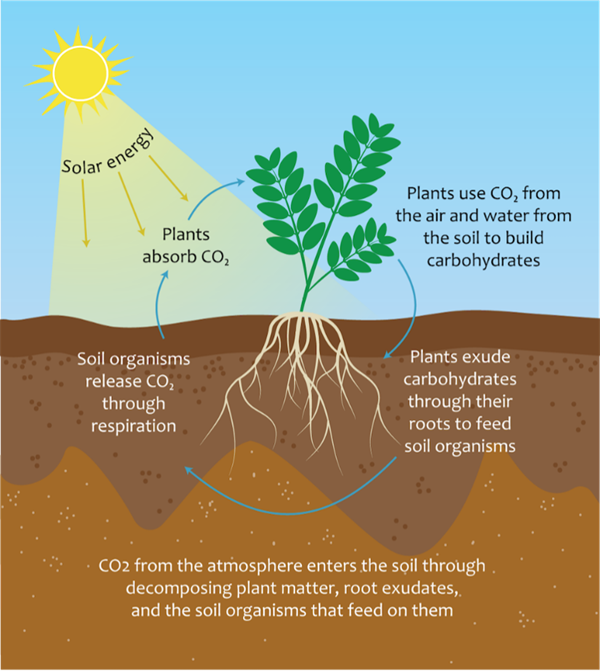
Figure 2. The broad and integrated aspects of soil health and relationship to human health. Source: van Es and Frost, 2016.
In agricultural systems these relationships are commonly recognized but this new emphasis is good in my view because of the capacity to bring the importance of soil systems into a better realm of understanding and appreciation by the public and non-agriculturalists who have never really thought about this before. It is also important for us to recognize that whatever we do to impact a soil system in one aspect, it will have impacts on other aspects as well.
The study of soil fertility in the context of soil-plant relationships has often served to integrate the physical, chemical, and biological properties in relation to plant or crop growth. The concepts of soil health commonly place an emphasis on soil carbon (C) content, particularly in relation to stable organic carbon (SOC). This is related to the common reference to soil organic matter (SOM) content in soil health discussions.
It is important to distinguish the difference between organic materials and organic matter in soils. Organic materials include crop residues and SOM is the stable, residual forms of C compounds left in soils following microbial decomposition. For example, after the harvesting of a crop the crop residues are organic materials and they do not equate to SOM. The SOM is the final result of the crop residue breakdown and it is usually a very small fraction of the total organic material that was originally deposited.
Soil organic C represents the net balance of inputs and outputs of C to the soil over time. Inputs of C into a soil system consist largely of root exudates, residues of leaves, stems, and roots, and it also includes the deposition of materials transported by wind and water. In agricultural systems these inputs can include organic amendments such as manure, compost, biosolids, biochar, etc. to supply nutrients or organic matter.
Inputs of C into the soil system are counterbalanced by the C outputs which are dominated by the mineralization of SOC to carbon dioxide by microbes. In an agricultural soil system, microbial degradation and the transformation of plant inputs creates a complex of microbially derived organic compounds in the soil (Grandy and Neff, 2008). Outputs also include any harvested crops, residue burning and erosion.
Typically, soil health measurements focus on the soil surface properties, usually the upper foot (30 cm) of the soil surface. Thus, the transport of C deeper into the soil profile by water or tillage pedoturbation would result in a decrease in the measured SOC in the surface.
In a desert agricultural setting, it is important to review the basics of C cycling in soil systems as shown in Figure 3.
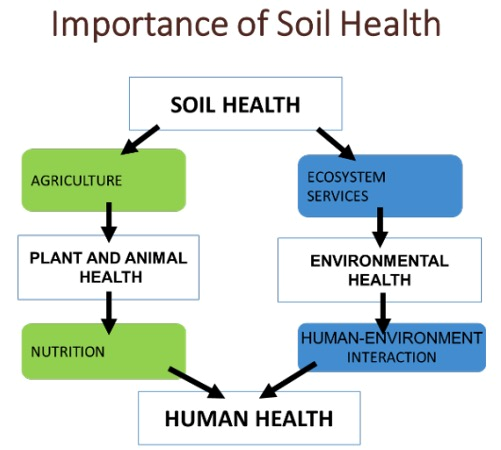
Figure 3. Soil carbon cycle. Source: Lavallee and Cotrufo, Colorado State University, 2020.
Desert crop production systems can produce large amounts of organic material, plant structures and residues. However, much of the C captured in plant residues and incorporated into the soil is soon lost to the atmosphere due to the high amounts of solar energy inputs, an abundance of soil microbes, with sufficient soil moisture and aeration as a function of good soil drainage, and a good nutrient supply (particularly nitrogen).
These are all functions of healthy soils, which are common in desert agricultural settings. The result is a relatively low level of stable organic matter (SOM), usually less than 2% on a soil mass basis and most often ~ 1% or less in desert agricultural soils. Even if difficult, trying to enhance SOM accumulation in desert soils is a worthy goal.
It is important to understand the basic concepts and complexities associated with soil health and to consider agronomic aspects (soil and crop factors) of soil and crop system management that serve to enhance healthy soils for both short and long-term productivity and sustainability.
References
Lavallee, J. and F. Cotrufo, 2020. Soil carbon is a valuable resource, but all soil carbon is not created equal. The Conversation and Colorado State University, 2020.
https://theconversation.com/soil-carbon-is-a-valuable-resource-but-all-soil-carbon-is-not-created-equal-129175
Grandy, A.S., Neff, J.C., 2008. Molecular C dynamics downstream: the biochemical
decomposition sequence and its impact on soil organic matter structure and
function. The Science of the Total Environment 404, 297–307.
https://doi.org/10.1016/j.scitotenv.2007.11.013.
USDA-Natural Resource Conservation Service (NRCS). 2015. Soil Quality Indicators Physical, Chemical, and Biological Indicators for Soil Quality Assessment and Management.
https://www.nrcs.usda.gov/sites/default/files/2022-10/indicator_sheet_guide_sheet.pdf
USDA-NRCS. 2022. https://www.nrcs.usda.gov/wps/portal/nrcs/main/soils/health/
van Es, H. and P. Frost. 2016. Gaining Ground on Soil Health. Tata Cornell Institute.
https://tci.cornell.edu/?blog=gaining-ground-on-soil-health
This study was conducted at the Yuma Valley Agricultural Center. The soil was a silty clay loam (7-56-37 sand-silt-clay, pH 7.2, O.M. 0.7%). Spinach ‘Meerkat’ was seeded, then sprinkler-irrigated to germinate seed Jan 13, 2025 on beds with 84 in. between bed centers and containing 30 lines of seed per bed. All irrigation water was supplied by sprinkler irrigation. Treatments were replicated four times in a randomized complete block design. Replicate plots consisted of 15 ft lengths of bed separated by 3 ft lengths of nontreated bed. Treatments were applied with a CO2 backpack sprayer that delivered 50 gal/acre at 40 psi to flat-fan nozzles.

Downy mildew (caused by Peronospora farinosa f. sp. spinaciae)was first observed in plots on Mar 5 and final reading was taken on March 6 and March 7, 2025. Spray date for each treatments are listed in excel file with the results.
Disease severity was recorded by determining the percentage of infected leaves present within three 1-ft2areas within each of the four replicate plots per treatment. The number of spinach leaves in a 1-ft2area of bed was approximately 144. The percentage were then changed to 1-10scale, with 1 being 10% infection and 10 being 100% infection.
The data (found in the accompanying Excel file) illustrate the degree of disease reduction obtained by applications of the various tested fungicides. Products that provided most effective control against the disease include Orondis ultra, Zampro, Stargus, Cevya, Eject .Please see table for other treatments with significant disease suppression/control. No phytotoxicity was observed in any of the treatments in this trial.
In previous articles, I have discussed using band-steam to control plant diseases and weeds. Band-steam is where, prior to planting, steam is injected in narrow bands (4” wide x 2” deep), centered on the seedline to raise soil temperatures to levels sufficient to kill weed seed and soilborne pathogens (>140 °F for >20 minutes). After the soil cools (<1 day), the crop is planted into the strips of disinfested soil.
This summer, project Co-PI, Steve Fennimore, Extension Specialist – Weed Science, UC Davis has been evaluating the efficacy of using band-steam to control weeds and cavity spot (Pythium spp.) in carrot. The trials are still in progress, but so far, the technique has been found to be very promising for weed control (Fig. 1).
Using steam to control weeds in high density crops such as carrot, baby leaf spinach and spring mix may be a particularly good fit for the method. Handing weeding in these crops is labor intensive and costs are high, typically exceeding $300/acre (Fig. 2). Costs are even greater in organic crops. A benefit of steam application is that it is organically compliant.
This fall, we will be developing a steam applicator designed for use on wide beds. We’ll be trialing the device in baby leaf spinach and spring mix. If you are interested in this application, we’ll be demonstrating weed control in baby leaf spinach using steam heat at the UA 3rd AgTech Field Day. The event will be held Tuesday, October 25th at the Yuma Ag Center.
Acknowledgements
This work is supported by the Arizona Specialty Crop Block Grant Program and the Crop Production and Pest Management grant no. 2021-70006-35761 /project accession no. 1027435 from USDA-NIFA. We appreciate their support. Any opinions, findings, conclusions, or recommendations expressed in this publication are those of the author(s) and do not necessarily reflect the view of the U.S. Department of Agriculture.
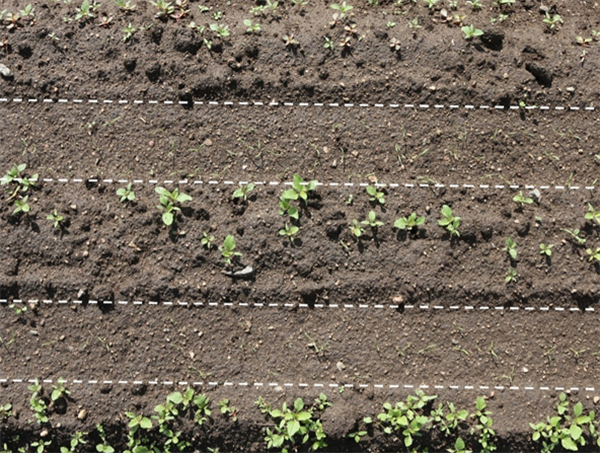
Fig. 1. Weed control with band steaming in carrot. Steam was applied in a 4-inch band centered on the two seedlines (between the dashed white lines) prior to planting. The weeds outside of the treated band can be easily removed through cultivation. (Photo credits: Steve Fennimore, UC Davis).
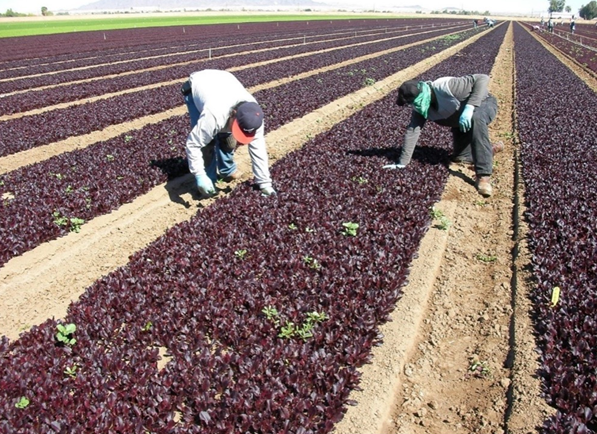
Fig. 2. Hand weeding in crops seeded at high densities is labor intensive.
One of our local PCAs (Pest Control Advisors) in Yuma, Arizona found Buffalobur nightshade last week in an artichoke field in the area.
Buffalobur is a summer annual that belongs to the Solanaceae family. Another weed from this family commonly seen is Silverleaf nightshade (Solanum eleagnifolium). Unlike Silverleaf that has a purple flower, Buffalobur has a yellow flower. Leaves are deeply lobed from half to all the way to the midrib resembling small watermelon leaves. Sometimes toothed, the leaves are alternate on the stems with star-shaped hairs and are TOXIC TO HUMANS AND LIVESTOCK.
Animals would have to consume 0.1-0.3 % of their bodyweight to have toxic effects. Goats and sheep are more resistant than cattle to the weed's glycoalkaloid solanine, which is the toxic agent [3].
Its named Buffalobur for the prickly burs that got entangled to the fur of the bisons. Plants can reach up to 60 cm tall [2].
This weed is a natural host of the Colorado Potato Beetle (Leptinotarsa decemlineata). It is also an alterative host of some mosaic virus affecting potato, tomatoes, and alfalfa. Additionally, it can harbor nematodes that are damaging to tomatoes [1].
According to the National Noxious Weed Control Board 2,4-D and Banvel are herbicides that provide complete control of this weed [3].
If infestations are small, it is also recommended to remove plants wearing sturdy gloves. The objective is to prevent the mature burs from releasing seeds when dehiscence occurs increasing the infestation.
Thank you for sharing your findings with the University of Arizona Vegetable IPM Team.
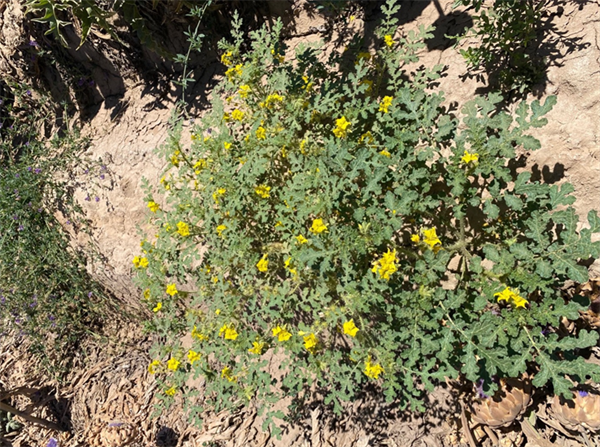
Image Courtesy of Jim Daily
References:
Results of pheromone and sticky trap catches can be viewed here.
Corn earworm: CEW moth counts down in all traps over the last month; about average for December.
Beet armyworm: Moth trap counts decreased in all areas in the last 2 weeks but appear to remain active in some areas, and average for this time of the year.
Cabbage looper: Moths increased in the past 2 weeks, and average for this time of the season.
Diamondback moth: Adults increased in several locations last, particularly in the Yuma Valley most traps. Below average for December.
Whitefly: Adult movement remains low in all areas, consistent with previous years
Thrips: Thrips adult movement continues to decline, overall activity below average for December.
Aphids: Winged aphids still actively moving but declined movement in the last 2 weeks. About average for December.
Leafminers: Adult activity down in most locations, below average for this time of season.